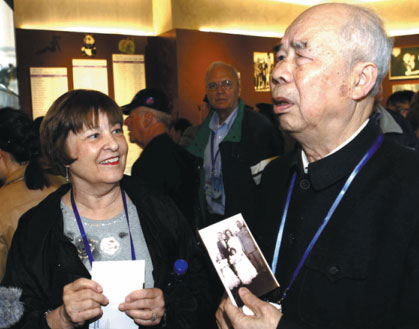
Long Fenggao (right), who helped save a pilot when he was 9, chats with a fellow guest at a Flying Tigers memorial event in Guilin in March. (Huo Yan/China Daily)
Unorthodox tactics
Using Chennault's unorthodox tactics, which involved attacking in pairs and making diving passes at the enemy, the squadron destroyed almost 300 Japanese aircraft, losing only 12 of their own. The Flying Tigers, as they came to be known, were formally absorbed into the U.S. military in 1942 as the 14th Air Force under the command of Chennault.
According to Chinese historian Ge Shuya, by 1941, China's fledgling air force had been decimated. The Tigers, which expanded to a force of about 3,000 planes, helped turn the tide.
"For (one period of) 199 days, Japan's 2,452 aircraft bombed one city (Kunming, Yunan province) 465 times," Ge said, "It is the arrival of the Flying Tigers that turned the situation around.
They went on to destroy more than 2,500 enemy aircraft, sink or cripple 45 naval ships and 2.23 million metric tons worth of enemy merchant vessels, and kill more than 66,700 enemy troops.
Flying Tiger veteran David Hayward, 93, said it could not have been done without the assistance of the Chinese. The Los Angeles-based retiree, who flew 53 combat missions in a B-25 bomber between 1943 and 1944, said the skies above wartime China were a dangerous place.
"The first three months we operated in China, 12 of our squadron of 16 airplanes were lost," he said. "They were lost either by Japanese attacks, or anti-aircraft fire from the ground, or simply crashing into a mountain. I had a lot of close calls."
The help from Chinese allies was vital, he said. "We had something called the Chinese net, an early warning system, maintained by the Chinese. They would warn us when enemy airplanes were approaching, so we could put our planes in the air.
"Some of the crews were able to bail out or make crash landings (after they were shot down). We had several cases in our squadron where men had to bail out of their airplane and were helped back to friendly lines by the Chinese. It was very reassuring."
In Yangtang in 1944, villages carried the downed U.S. airman, who had wounds to his legs, using a wooden board, traveling through the night until they reached a U.S. air base near Guilin in the early hours. Long said he guided the way through the darkness with an oil lamp.
Despite the divides in culture and language, Long, now 81 and a retired police officer, has no doubt he helped save a friend and ally that night.
"All my family died in the Japanese bombings," he said. "The Flying Tigers helped me to take revenge. I regard their families as my family. I'm honored to have helped save that injured U.S. pilot, even though I never knew his name."
















































